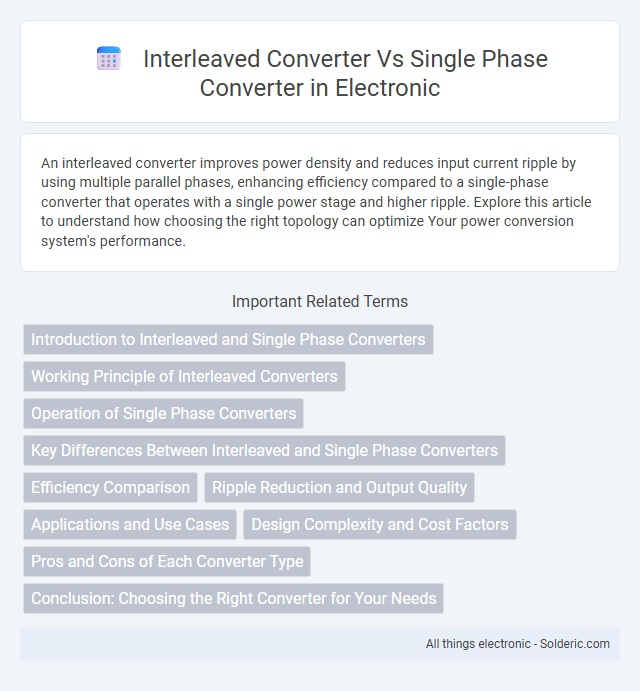An interleaved converter improves power density and reduces input current ripple by using multiple parallel phases, enhancing efficiency compared to a single-phase converter that operates with a single power stage and higher ripple. Explore this article to understand how choosing the right topology can optimize Your power conversion system's performance.
Comparison Table
| Feature | Interleaved Converter | Single Phase Converter |
|---|---|---|
| Topology | Multiple parallel phases, interleaved operation | Single phase input and output |
| Current Ripple | Reduced due to phase interleaving | Higher ripple current |
| Power Handling | Higher, suitable for high power applications | Lower power capacity |
| Efficiency | Higher due to reduced losses and ripple | Lower efficiency, more heat generation |
| Component Stress | Distributed among phases, lower stress | Concentrated stress on components |
| Size and Cost | More complex, higher component count and cost | Simpler, smaller, cost-effective |
| Applications | High power DC-DC converters, telecom, servers | Low power conversion, simple power supplies |
Introduction to Interleaved and Single Phase Converters
Interleaved converters distribute power conversion across multiple phases, reducing current ripple and improving thermal performance compared to single phase converters. Single phase converters handle power conversion through one phase, typically resulting in higher output voltage ripple and greater stress on components. Interleaved designs enhance efficiency and reliability in applications requiring high power density and minimized electromagnetic interference.
Working Principle of Interleaved Converters
Interleaved converters operate by paralleling multiple converter phases with staggered switching intervals to reduce ripple current and improve thermal management, contrasting with single-phase converters that handle power in a single switching cycle. Each phase in an interleaved converter shares the load current, allowing for smaller passive components and higher efficiency with reduced electromagnetic interference. Your power conversion system benefits from enhanced dynamic response and longer component lifespan due to the balanced current distribution and continuous energy transfer inherent in interleaved converter designs.
Operation of Single Phase Converters
Single phase converters operate by converting AC input power to a DC output using controlled semiconductor devices like thyristors or diodes, allowing precise voltage regulation. These converters are commonly used in low to medium power applications where simplicity and cost-effectiveness are prioritized. Understanding your single phase converter's operation can help optimize performance in applications such as battery charging, motor drives, and power supplies.
Key Differences Between Interleaved and Single Phase Converters
Interleaved converters feature multiple phases operating out of sync to reduce ripple current and improve thermal performance, whereas single phase converters rely on one phase, resulting in higher ripple and stress on components. The interleaved design delivers higher efficiency and better current handling, making it ideal for high-power applications compared to the simpler and less expensive single phase converter. Understanding these key differences helps you select the right converter type for your power management needs.
Efficiency Comparison
Interleaved converters exhibit higher efficiency than single-phase converters due to their ability to distribute current across multiple phases, reducing conduction and switching losses. The interleaved topology improves thermal management by lowering device stress and spreading heat dissipation, leading to enhanced performance under high load conditions. Single-phase converters typically suffer from higher ripple current and increased electromagnetic interference, which can further degrade efficiency in power conversion applications.
Ripple Reduction and Output Quality
Interleaved converters achieve significant ripple reduction by distributing current across multiple phases, which lowers the overall output current ripple compared to single-phase converters. This multi-phase operation improves output quality by providing a more stable voltage with reduced electromagnetic interference (EMI) and enhanced efficiency. Single-phase converters typically exhibit higher output voltage ripple and increased stress on components, leading to less optimal power delivery and potential reliability issues.
Applications and Use Cases
Interleaved converters offer high efficiency and reduced ripple current, making them ideal for applications in electric vehicles, renewable energy systems, and high-power industrial drives where smooth power delivery and thermal management are critical. Single phase converters, with their simpler design and lower cost, suit residential solar inverters, small motor drives, and consumer electronics where moderate power levels and compactness are priorities. Your choice depends on balancing power requirements, efficiency, and system complexity for the specific application.
Design Complexity and Cost Factors
Interleaved converters feature multiple phases operating in parallel, which increases design complexity due to the need for synchronized control circuits and additional components like inductors and switches. Single-phase converters are simpler and more cost-effective, requiring fewer parts and less elaborate control mechanisms, making them suitable for applications with lower power demands. Your choice depends on balancing the higher efficiency and reduced ripple of interleaved designs against the budget and simplicity offered by single-phase converters.
Pros and Cons of Each Converter Type
Interleaved converters offer higher efficiency and reduced current ripple due to parallel operation of multiple phases, making them ideal for high-power applications; however, they are more complex and costly to design and maintain. Single-phase converters provide simplicity, lower cost, and ease of implementation, but suffer from higher output current ripple and limited scalability in power handling. The choice depends on the trade-off between efficiency, cost, complexity, and power requirements of the specific application.
Conclusion: Choosing the Right Converter for Your Needs
Interleaved converters offer higher efficiency and lower ripple current, making them ideal for high-power applications requiring improved thermal management and reduced electromagnetic interference. Single-phase converters provide simplicity, lower cost, and ease of implementation, best suited for low to medium power uses with less stringent performance demands. Selecting the right converter depends on balancing power requirements, cost constraints, and the need for efficiency and noise reduction in your specific application.
Interleaved converter vs Single phase converter Infographic

 solderic.com
solderic.com